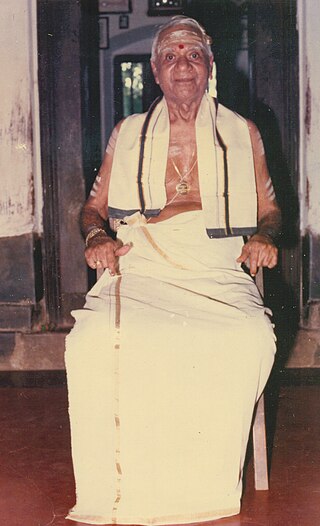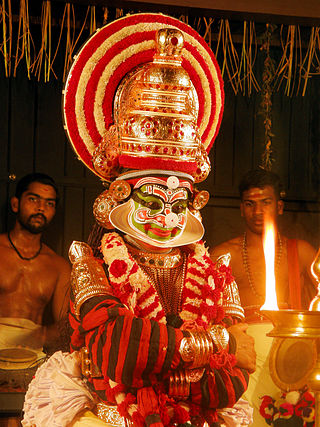
Koodiyattam is a traditional performing art form in the state of Kerala, India. It is a combination of ancient Sanskrit theatre with elements of Koothu, an ancient performing art from the Sangam era. It is officially recognised by UNESCO as a Masterpiece of the Oral and Intangible Heritage of Humanity.

Ottan Thullal is a recite-and-dance art-form of Kerala, India. It was introduced in the eighteenth century by Kunchan Nambiar, one of the Prachina Kavithrayam. The folksy performance, often laced with humour intended at criticism of society, is accompanied by a mridangam and/or the handy idakka besides a pair of ilathalam cymbals.

Kunchan Nambiar was a prominent Malayalam poet of the 18th century (1705-1770). Apart from being a prolific poet, Nambiar is also famous as the originator of the dance art form of Thullal, most of his works were written for use in Thullal performances. Social criticism wrapped in humour is the hallmark of his works. Nambiar is one of the foremost comedians in Malayalam.

Koothambalam or Kuttampalam meaning temple theatre is a closed hall for staging Koothu, Nangiar koothu and Koodiyattam, the ancient ritualistic art forms of Kerala, India. Koothambalams are said to be constructed according to the guide lines given in the chapter 2 of Nātyasāstra of Bharata Muni. The stage within the hall is considered to be as sacred as the temple sanctum. It is constructed within the cloister of the Temple; more precisely within the pancaprakaras of the temple. The prescribe location is between the prakaras of bahyahara and maryada. In Kerala tradition it is considered as one among the pancaprasadas of a temple complex. Its dimension vary from temple to temple. A square platform with a separate pyramidal roof supported by pillars in the center called natyamandapam is constructed as s separate structure within the large hall of Koothampalam. The floor of the hall is divided into two equal halves and one part is for performance and other half for seating audience. During the performance, the stage is decorated with fruit-bearing plantains, bunches of coconuts and fronds of the coconut palm. A para filled with rice is placed on the stage. A nilavilakku with three thiri is used for lighting. The mizhavu, a percussion instrument for accompanying Koothu, is placed within a railed enclosure, with a high seat for the drummer( belonging to nampiar community).

A mizhav or mizhavu is a big copper drum played as an accompanying percussion instrument in the Koodiyattam and Koothu, performing arts of Kerala. It is played by the Ambalavasi Nambiar community. After 1965, when started a mizhavu repertory in kalamandalam mizhavu break the caste barrier and nowadays anyone can play mizhavu in koodiyattam, nangiar koothu, chakyar koothu, and mizhavu thayambaka.

Mani Damodara Chakyar is a Kutiyattam and Chakyar Koothu artist in Kerala state of south India. He is a nephew and disciple of legendary guru Nātyāchārya Vidūshakaratnam Padma Shri Māni Mādhava Chākyār. He belongs to the great Mani Chakyar tradition of Koodiyattam and Chakyar koothu.

Guru Mani Madhava Chakyar (15 February 1899 – 14 January 1990) was a celebrated master performance artist and Sanskrit scholar from Kerala, India, considered to be the greatest Chakyar Koothu and Koodiyattam artist and authority of modern times. He was considered as the authority of Abhinaya and Nātyaśāstra.

Chakyar Koothu is a performance art from Kerala, India. It is primarily a type of highly refined monologue where the performer narrates episodes from Hindu epics and stories from the Puranas. Sometimes, however, it is also a traditional equivalent of the modern stand-up comedy act, incorporating commentary on current socio-political events.
Avittathur is a small village in Thrissur district of Kerala state, India. It was one of the 64 original Brahmin settlement in the Kerala state. It is famous for an ancient shiva temple, where 4 very old inscriptions have been discovered. According to legend, the temple was consecrated by sage agastya and the name of the village was originally agastyaputtur but it seems to be just the Sanskritization of the word. Legendary Chakyar Koothu and Koodiyattam maestro Nātyāchārya Vidūshakaratnam Padma Shri Māni Mādhava Chākyār used to perform here for decades.

Thiruvangad Sree Ramaswami Temple is a temple located in the eastern part of Thalassery. The temple is generally known as the Brass Pagoda from the copper sheeting of its roof. A part of the temple was damaged by Tipu Sultan's troops in the 18th century, but the temple is believed to have been saved from destruction. It was one of the outposts of the Thalassery fort in the 18th century. Conferences between the officials of the East India Company and local leaders in its precincts, at which political treaties and agreements were signed. The annual festival of the temple commences on Vishu day in Medam and lasts for seven days.

Nātyakalpadrumam is a book written by Guru Māni Mādhava Chākyār, considered the greatest exponent of Koodiyattam and Abhinaya in Kerala, about all aspects of ancient Sanskrit drama theatre tradition of Kerala—Kutiyattam. It was first published in Malayalam (1975) by Kerala Kalamandalam, with financial assistance of Sangeet Natak Academi, New Delhi. This work serves as a reference to both scholars and students. The entire book is written in the old Sanskrit text style closely following Nātyaśāstra. The structure and content of the book alike illustrate the knowledge of the author in both Sanskrit and Nātyaśāstra. The work received the Kerala Sahitya Academy Award in the year 1975. A Hindi translation has been published by the Sangeet Natak Akademi, New Delhi.
The Nambiar is a Hindu Ambalavasi caste of Kerala. Ambalavasi Nambiars wear sacred thread like Brahmins and is traditionally considered as a different caste to Nairs including same name bearing Nair-Nambiar caste, who were traditionally the feudal landlords of northern Kerala which usually leads to confusion.

Nangiar koothu or Nangyar Koothu is an allied traditional art of Kutiyattam, an age-old Sanskrit drama tradition of India. It is performed traditionally by the women of the Ambalavasi Nambiar community of Kerala, known as Nangyaramma, but since the second half of the 20th century it's no longer the case.

Mani Madhaveeyam is a biographical book written on the life of Guru Māni Mādhava Chākyār (1989–1991), who was the greatest Kutiyattam-Chakyar Koothu exponent and Rasa-abhinaya maestro of modern times. The book is published by the Department of Cultural Affairs of Government of Kerala, India in May 1991. The author of the book is Das Bhargavinilayam
Late Shri Guru Painkulam Raman Chakyar was a Chakyar Koothu and Koodiyattam performer. He won the Kerala Sangeetha Nataka Akademi Award in 1972. He was also a teacher of Vachika Abhinaya in both Chakyar Koothu and Koodiyattam.
Paanivadathilakan P. K. Narayanan Nambiar was an Indian musician, known for his virtuosity in Mizhavu, a traditional percussion instrument and his scholarship in the art of Koodiyattom. He is considered to be one of the masters of Koodiyattom. In 2008, he was awarded Padmashri by Government of India for his services to the art.
Kalamandalam Sivan Namboodiri is an Indian classical theatre performer, the first person from outside chakyar community to practice Koodiyattam, from Kerala. He was awarded the Padma Shri, in 2012, for his contributions to the art of Koodiyattam, by the Government of India.

Moozhikkulam Kochukuttan Chakyar (1928–2009) was an exponent of Koodiyattam, a traditional form of Sanskrit theatre from Kerala, which has been recognised by UNESCO as an Oral and Intangible Heritage of Mankind. Born in a family of Koodiyattam performers, in 1928, at Ammannur, a small hamlet near Irinjalakuda, in Thrissur district in the south Indian state of Kerala, Chakyar had his early training in the art form from within his family. Ammannur Madhava Chakyar, a renowned Koodiyattam performer and a Padmabhushan awardee, was his cousin and the two, later, would evolve a new school of performance, popularly known as the Ammannur tradition of Koodiyattam. When Margi, an institution promoting traditional art forms of Kerala, started their Koodiyattam training centre in 1981, he was the first residential guru. The institution imparted training to many aspiring performers which included two sons of Chakyar, Margi Sajeev Narayana Chakiar and Margi Madhu and both of them are known exponents of the art form. In 1998, Chakyar joined Nepathya, a centre for excellence in Kudiyattam, as the Mukhya Acharya, and continued his association with the institution till his last. The Government of India awarded him the fourth highest civilian honour of the Padma Shri, in 2008, for his contributions to Arts. He died in 2009, at the age of 81. He is remembered by an annual festival, Guru Moozhikkulam Kochukuttan Chakyar Memorial Kutiyttam Festival, at Moozhikkulam, a suburb of Kochi where Nepathya is headquartered in, and through orations organised by Nepathya.
Palakkad district has a large number of temples, churches, mosques and other tourist attractions. Palakkad district is situated in the middle of Kerala state in South India. The nearest airports are at Coimbatore in Tamil Nadu and Cochin in Kerala.

Pathakam is a traditional temple art form of Kerala in which stories from Hindu Puranas are narrated.



















